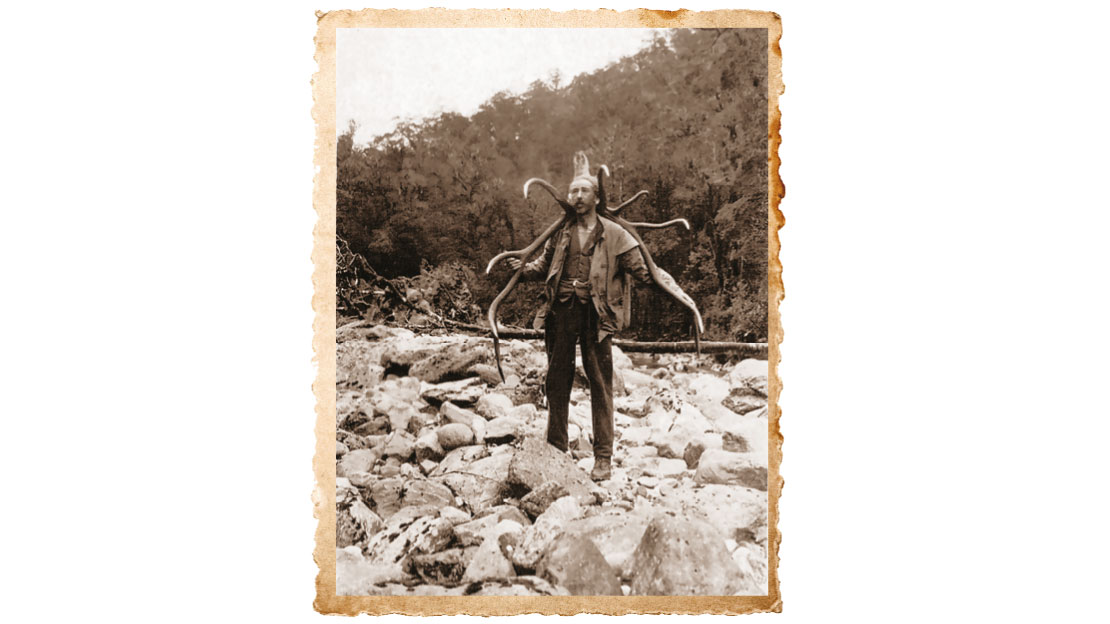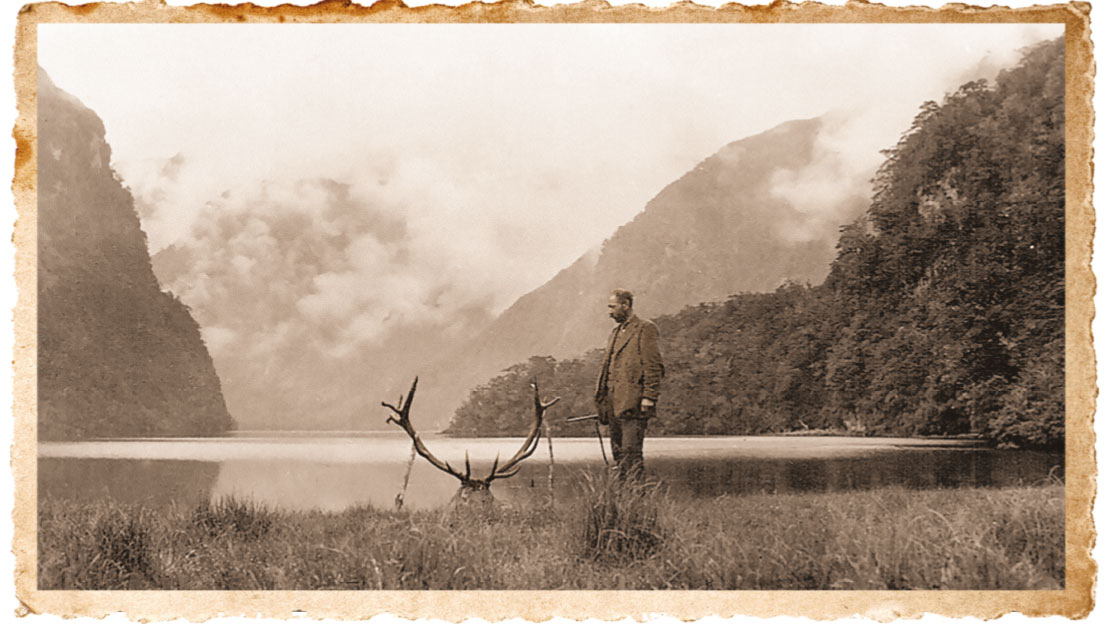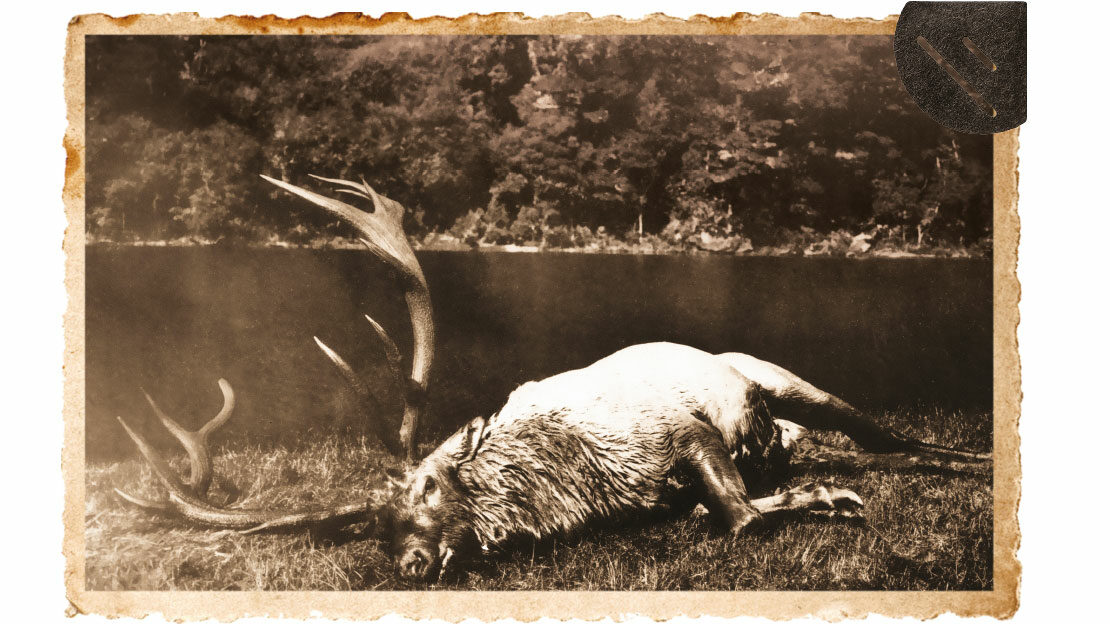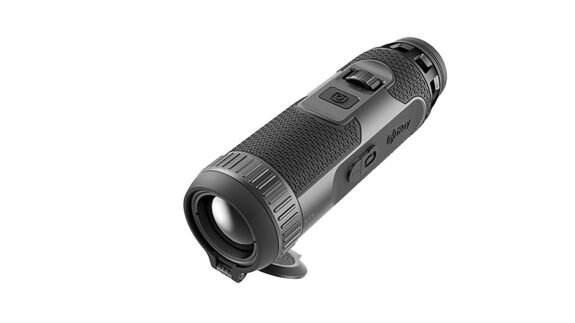The Donald family name is one which is firmly cemented in New Zealand’s agricultural history, but it can also be said to be equally connected to New Zealand’s early hunting history.
Vivian Everard Donald was born in the Wairarapa at Masterton on 17 July 1878. His father’s inventiveness had produced the Donald Wool Press, which had led to the founding of a unique manufacturing business serving the farming sector.
As a youngster, Donald’s life was secure and happy. He was brought up in a caring family environment in which his parents worked extremely hard to provide a good upbringing and education for their children. From his teenage years Donald worked hard in his father’s business, eventually taking it over upon the senior’s retirement. He was also a very good all-round sportsman, playing rugby to a representative level, along with club cricket, tennis and golf, the latter to local championship grade.
But it was deerstalking that became his most passionate recreational pursuit, an activity in which his father encouraged him. The pair often trekked the Tararuas together, seeking gold and hunting deer.
Later, as Donald’s involvement in the family business began to limit his opportunities to visit the back country, he maintained his interest by taking up competitive rifle shooting, excelling in the discipline and becoming an accurate and reliable rifleman. In the early 1900’s he captained the first New Zealand Rifle Association team to Australia, where he represented the Wairarapa, Manawatu and Hawkes Bay, and he later became president of the Opaki and Wairarapa Rifle Clubs. In 1924 he won the Opaki Championship and Bisley Aggregate Shoot at Trentham.
Marriage
In 1904 Vivian Donald married Blanche Mills, the daughter of the Rt Hon. C H Mills, and that same year built a grand residence in Masterton which he called ‘Lansdowne’. Here he and Blanche raised their family of eight children, sadly losing two at a young age.
Along with his many and varied sporting and business attributes, Donald was an avid gardener and the gardens surrounding the homestead were maintained to a meticulous standard. He was also interested in collecting early New Zealand art and Maori artefacts and his collection, which included his hunting trophies, all housed at Lansdowne, was recognised as quite extraordinary for that period. When Donald’s son Val resided at Lansdowne, I was given a guided tour of the trophies and treasures, an occasion I have never forgotten.
During his involvement in the agricultural business, Vivian Donald was friendly with Cantabrian Colin Deans, who then lived in Masterton. Deerstalking in the South Island was keenly pursued by Deans and his brothers, all of whom lived on farms they owned in Canterbury.

Heading South
Colin Deans went on to assist Donald in the planning and undertaking of his first South Island stalking campaign in 1919. Prior to the season’s opening on 1 April, Donald and his friend Harold Bennett had travelled to the wide braided Canterbury valley of the Rakaia River at Mount Algidus where they were guests of Mr and Mrs W Urquhart. It appears that local prospects for the stalkers were not the brightest; the previous winter had been harsh, and predictions from the likes of Jack Forbes and Harold Hodgkinson indicated it would be a difficult season for locating and taking a trophy. Their observations also suggested that the antler potential was deteriorating in the vicinity of Manuka Point owing to the unchecked numbers of deer there. Nonetheless, the Urquharts were happy to provide them with an experienced pack man, and Donald and Bennett set off for Blocks 8 and 9 on Totara Point.
The 1919 season was also the first time that the Ashburton Acclimatisation Society had issued Licence holders with a coloured map of the stalking grounds. The allocated country was an extensive mix, which took in a rugged rough mountain valley draining to the Rakaia, plus extensive river flats between the Mathias Valley and Manuka Point. The herd was English Stoke Park/Windsor which, when established in Canterbury and Westland, had produced some outstanding trophies, equal to the world’s finest during the halcyon years.
Near Totara Point the party set up base camp in a hut, only to become disappointed and frustrated after nearly two weeks of stalking. They would telescope or close in on roaring stags with apparently excellent antlers, only to discover that they had no bez tines, a defect which would plague the herd for years to come.
Good one!
One day he and Bennett set out from camp just on light, keen to investigate a roaring stag they’d attempted to look over the previous day. While the roaring of many stags provided a fabulous atmosphere, the animal in question had sounded somehow superior. The pair had not made Totara Stream where they intended to look for the beast before they heard and noticed a large stag moving across the river flats. Donald set out to close the range. When the stag stopped walking to roar at a competitor, Donald was positioned and brought the beast down with a single shot from his .280 Ross rifle. That morning Vivian Donald bagged the best of the Rakaia red deer trophies for the 1919 season – a big-boned, big-bodied, very even 16-pointer. It measured a splendid 42½ inches in length, with a span of 30 inches. The two stalkers collected several other stags but none bettered that beast.
In the 1921 season Donald made the long journey to Southland to try his luck around Lake Manapouri. He had made the acquaintance of the Murrell brothers and was a guest at the boarding house the family operated; the association with Les Murrell as his guide and friend was to be beneficial for his stalking adventures in the years ahead. Les took Donald into the vast bushlands beneath the Monument where they encountered a lot of deer, and Vivian was more than happy to take two stags of reasonable quality: one a 15 pointer measuring 40¼ inches in length and a spread of 37⅛ inches, and the other a 14 that went 37⅝ inches in length with a spread of 31½ inches. Later scored on the Douglas System, the antlers went 318⅜ and 303 respectively.
During 1922, Donald returned. Accompanied by his 14-year-old daughter Margaret, who had her own deer licence, he reached Lake Manapouri on April 29. Also in the party was Donald’s friend Richard Barton. Murrell was able to guide Margaret onto two 13 pointers and a 10, while Richard Barton appreciated his guide’s endeavours to help him secure two 12’s and an 11 pointer. After two weeks of stalking the lakeside vicinity, Donald and Murrell decided to set out for a six-day flying camp excursion to the open tops, with Donald remarking in his notes about the wonderful slice of country they were able to view, particularly the brilliance of Mount Titiroa.
A lot of deer were sighted – in fact the first stag spotted as soon as they reached the tops actually cantered over to them to investigate! The 11 pointer was brazen enough to let them carry on and stood its ground while two more stags joined him to watch as the pack-carrying individuals passed. Donald shot a pleasing 14 pointer, although its measurements were not recorded.
FIORDLAND Moose?
Donald’s interest in and knowledge of Southland’s Fiordland region was increasing. His drive, combined with Murrell’s experience, made it a given that some of the focus of their discussions would involve a search for the elusive moose and wapiti herds. The New Zealand Government had finally reignited interest in these species and in 1921 Fred Moorehouse was sent to George Sound to conduct a survey aimed at establishing whether or not the animals were in the area. Since their original liberation, the wapiti in 1905 and the moose in 1910, mystery had surrounded their status, establishment and spread. After receiving Moorehouse’s findings, the Government decided to send in Ranger Charles Evans the following year; he prepared another report for the Government, as well as one for the Southland Acclimatisation Society. Based on this, the Acclimatisation Society decided to prepare for an open hunting season in 1923. Two licences for moose and wapiti were duly issued, along with a special permit for two other hunters to take one wapiti and conduct a survey of the animals’ spread around the Lake Hankinson area on the Eastern side of the Main Divide. Competition among applicants was strong and the eager licence recipients, namely Vivian Donald and Leslie Murrell, commenced their George Sound expedition soon after the first week of April 1923. The two laden hunters climbed overland by way of Murrell’s track from Lake Manapouri into Deep Cove, in what was then Smith’s Sound (later to become Doubtful Sound). The Murrell’s 36 foot motor launch Constance was berthed there, ready for the voyage to George Sound.
The head of the sound was reached on 10 April, and they set up a small camp near the confluence of the Katherine Valley. Later next morning they cautiously sneaked their way upstream, reaching Lake Katherine before midday – where, using their telescopes, they jubilantly spotted a large bull wapiti on a sandy beach at the lake head.It was decided that Donald would try for the bull.
Two hours’ tough travel brought the bull into range at around 350 yards. Donald was a first rate shot and the .280 Ross rifle shot extremely flat; at 400 yards he knew precisely where the bullet would strike. Selecting a comfortable position and rest, Donald’s rifle split the Fiordland silence as the shot travelled true and the bull slumped sideways.
At that moment the sportsman from Masterton created New Zealand stalking history. The first wapiti bull taken under licence was his and between the two good friends a handshake was exchanged. Lunch would have tasted pretty good that day, sitting beside their lakeside prize. Photographs, dimensions and observation of the beast’s condition were all carefully recorded before the head and antlers were removed and the pair set out on the return. The size and weight of the massive antlers caused difficulty, making it a two-person mission for most of the way.

Photography
Vivian Donald’s photography skills were widely known and even extended to his having an arrangement with Kodak who supplied him with Kodak albums and film in exchange for the right to use his photographs. The photograph of Donald’s wapiti bull lying at Lake Katherine remains one of our most iconic hunting images and was later reproduced on the menu of passenger vessels sailing between New Zealand and the United Kingdom. The bull carried 14 points and measured 54¾ inches in length with a spread of 47¼ inches and a Douglas Score of 411¼.
After Vivian Donald took his great Lake Katherine trophy, the hunters moved their vessel around to George Sound’s southern reaches the following day. They were searching for further sign of wapiti before investigating the countryside around Lake Alice, but very few animals were spotted, so it was decided to withdraw from the valley. They also looked in Anchorage Cove before returning to the Katherine Valley camp.
Next morning a hunt upstream was repeated to where a wapiti bull was heard bugling; following a brief stalk, Donald shot it. This bull was lighter-boned than his first – a 15-point trophy measuring 53 inches in length with a spread of 37¾ inches. The following day they boated to Caswell Sound, which they reached just on dark. The night was spent on the boat and next morning, after some deliberation, it was decided to hunt the true right side of the river. While bush stalking the hunters came across a kakapo which Donald captured and took some very good photographs of before releasing it.
It is not a long haul to Lake Marchant from the confluence of Caswell Sound; reaching the lake, the hunters moved towards the river which flows from the North East. While negotiating this valley they heard a wapiti bugling, and this same beast was spotted a short time later with five cows. After a few minutes’ stalking, Murrell was in position to shoot – but unfortunately he only wounded the bull, which regained its feet and staggered into the river before it could finally be put down.
The bull ended up against a tree, but with the aid of supplejack vines and determination, Donald and Murrell eventually managed to get it onto dry land: an 11-pointer which had a length of some 48 inches and a spread of 45 inches. The following day they set out for the tops where they were most impressed by the unlimited snowy peaks and coastal vistas, all able to be enjoyed in the Fiordland sunshine. Strangely, they saw no wapiti and concluded that wapiti had yet to reach the open country, perhaps because of the quantity of feed available in the bush. With their licences filled, plus one bull taken for the New Zealand Government, the two hunters boated back to Deep Cove to refuel and replenish from supplies stashed there.
Dusky Sound
Dusky Sound was their next destination, where they intended to search for a moose trophy. They arrived in Supper Cove just on dark, anchored and slept on the boat – but before dawn next morning they were on their way to hunt the Seaforth Valley. Almost immediately it was obvious moose were about because of recent sign evident along the beach and valley floor. Red deer were also sighted and frequently heard, having been liberated in Dusky Sound around 1909.
The evidence of moose certainly boosted their morale, even though they were aware that they were too late in the season to have much chance of stalking a bull. It was apparent though that the number of animals in the vicinity was not great and that the dense bush cover and undergrowth would offer a rifleman little chance should a beast be sighted. On the following five days, hunting was undertaken in various Dusky Bay locations and as far inland as Loch Maree, all for the sighting of one cow moose.
Retreating to the Constance, the men returned around the wild South-West coast, to tie up at Riverton. From there they made their way to Invercargill where they were hosted by the Southland Acclimatisation Society who put on a special reception and meeting for them. Donald and Murrell reported on their hunt and trophy successes and displayed the antlers. Donald’s recommendation regarding moose was that only two licences should be issued for the next season, but for an earlier time-frame. Both stalkers confirmed that while the moose range was modest, the animals did indeed exist in Dusky Sound.

Chasing wapiti
For the 1924 season, seven wapiti licences spanning three blocks were issued, with Vivian Donald, his close friend Brigadier-General Herbert Hart and Les Murrell heading for another hunting adventure in Caswell Sound. They were able to access the block from the Constance.
On 17 April the party arrived at the head of Caswell Sound and the next day packed equipment to construct a camp upriver from Lake Marchant. Two party members returned to the lake the day after to carry a boat, which Murrell had built, upstream – a feat which took two days to achieve because of the obstacles and challenges that the river presented. This flat-bottomed craft was solidly built and capable of carrying three men plus their gear; the intention was to use it on the lake, whose forbidding sides made it otherwise impossible to traverse. Able to reach the lake’s end, Donald and Murrell scouted that area. While prints of a wapiti were discovered, they assumed these markings belonged to a bull they had found, recently drowned, in the lake. Consequently they decided that the animals had not reached this vicinity in any significant numbers yet.
From the Marchant camp Donald, Murrell and Hart stalked up the nearby river valley where they discovered a wide, deep and sinister-looking river and elected to name it “Stillwater,” a name it enjoys to this day. That hunting day was destined to be lucky for Les Murrell: he took a fine wapiti bull in a swampy stretch of open ground on the valley floor. The 50 inch antlers carried 13 points. His companions however departed the block without having fired a shot, their licences unfilled. The party generously left the boat behind for use by any others visiting the valley in the future.
Back again
The following season of 1925 saw the same three stalkers being lucky enough to repeat their Caswell Sound experience, this time joined by another associate of Donald’s, a gentleman called R A Renall. Weather-wise however, the period was really lousy – Fiordland at its best – and any hunting was controlled by the atrocious conditions, which restricted their stalking opportunities. Unbeknown to the party, their intended stay of 14 days would be extended to close on 25 days because the unrelenting rainfall only ceased for one day! One can only imagine reconstructing and setting up their base camp in such miserable conditions. On the fourth day, they set out to scout up the Stillwater. Bugling could be heard from all around, which lifted their spirits. As they traversed the valley towards the Feldspar Stream area, a bull challenged which Donald expressed an interest in.
The party waited and watched as the lone hunter faded into the rain and dense cover, and then came the reverberation of a single shot across the valley. Vivian Donald was rewarded with a 12 point bull with a length of some 54 inches and a spread of 50 inches. It was a handsome trophy indeed, with a Douglas Score of 401⅝. With Murrell’s help, Donald retrieved the head and they returned to camp for shelter, dry clothes and a warm fire; fortunately their camp was positioned on an elevated bench away from the rising river.
With what could be called ‘hunters’ luck’ they reached their base – only to hear a wapiti bugling from the bush opposite! Renall was urged to ready his rifle and he moved in, trying to pinpoint the bull’s location. After sneaking along the river’s other side, Renall finally caught sight of the wapiti and after a splendid shot the bull crashed to the ground. Across the raging waters there now lay a fine animal and Renall was delighted.
The river flow prevented any retrieval for days afterwards, and when it was finally attempted, it was undertaken with ropes and a lot of care. The stalker’s prize was an attractive 13 pointer with antlers exceeding 50 inches long and a spread of over 40 inches.

Success
Next it was the turn of Herbert Hart, who was desperate for a wapiti trophy, having had little luck the previous season; this saw him and Donald returning to the Stillwater again – and after a wet day’s bush-stalking they returned to base camp, both smiling and encircled by great wapiti antlers. Their two animals were taken in close proximity to each other and not far from Lake Marchant. Hart’s first-rate 14 point trophy was a beauty: 51 inches long with a spread of 49½ inches and a Douglas Score of 397⅜. Donald’s bull was a lengthy 11 pointer.
Considering the terrible weather, the Caswell Sound party had scored handsomely. Little further field time was spent; they sat out the remaining days waiting for safer weather conditions to return to Deep Cove – and when they did finally arrive, a heavy snowfall made for a hard and difficult climb over the Wilmot Pass to Lake Manapouri. It was a huge effort to carry their gear and antlers back to civilisation.
Donald’s intrepid times in the southern sounds and around Manapouri launched Les Murrell’s guiding career. His reputation was second-to-none for service and reliability, not forgetting his tremendous local experience and ability. His close friendship with Donald was lifelong and both men are formally recognised by the mountains and streams in the Caswell Sound back-country which bear their names.
Donald’s deerstalking continued until his final visit to Lake Manapouri in 1929 when, with Murrell as his guide, he took several good stags. During the early 1930’s Donald also hunted the North Island deer country at Te Awaiti on the Wairarapa east coast with the Riddifords and the Nitz brothers.
In their debt
Present-day deerstalkers should be grateful to individuals like Vivian Donald who unselfishly put such enthusiasm and expense towards attempting to create the culture of trophy hunting that we have today. His concise and thoughtfully-written reports and his ability to liaise with the Government and Acclimatisation Societies meant that many of his suggestions and advice were implemented by the authorities.
This well-respected businessman from Masterton collected a range of excellent red deer and wapiti trophies throughout his active stalking years – many of which are able to be viewed to this day in various clubs, meeting rooms and homes throughout New Zealand. His mighty reward from the Katherine Valley has long graced a wall in the Masterton Club, and I am sure that anyone wanting to see this icon of our hunting history would be warmly received by the Club.
In 1924 the British Embassy in Wellington asked Donald to send two magnificent wapiti heads to the Wembley Exhibition in the UK. They were crated up and shipped with the larger bull being insured for five hundred pounds. Donald’s trophies captured the attention of keen overseas sportspeople who were contemplating travelling to New Zealand to stalk. Sadly, both of these mounted heads failed to be returned home to Donald despite frequent requests, and they have since disappeared. To add to this loss, Donald’s family home ‘Lansdowne’ was razed by fire in 1991 and his lifetime collection, including most of his trophies, was destroyed. Other deer heads which he had gifted within his family have also become scattered and lost.
Vivian Everand Donald passed away on 21 December 1970 at the grand old age of 92 years. This unique sportsman and gentleman has generously left us the legacy of his epic accounts and photographs of hunting in back country New Zealand, in an era now gone.
Acknowledgements:
Personal comments: Haddon Donald, Robyn Williams; Donald Family photographs and reports; Great New Zealand Deerheads, D Bruce Banwell; Wapiti In New Zealand, D Bruce Banwell; Red Deer Stalking in New Zealand, T E Donne; Wapiti Hunting in New Zealand, Simon Gibson; The Wapiti, D. Bruce Banwell; A Nearly Complete History of the Moose in New Zealand, Ken Tustin.






SHARE YOUR BEST PICS #NZRODANDRIFLE